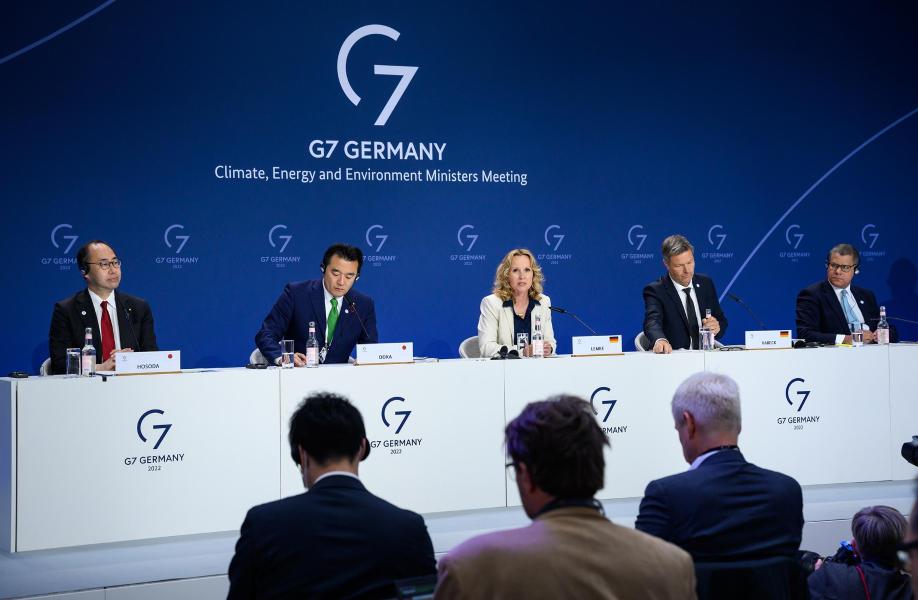Would increasing the share of female leaders improve efforts to fight climate change? Men and women disagree.
Climate change poses a unique threat to the livelihoods, health and safety of women and girls1. Women are more likely to die from a natural disaster than men in large part because they lack the financial resources to be prepared.
Women also work in areas particularly exposed to the negative effects of climate change, such as agriculture, fisheries, water and forestry2. In addition, girls’ lives tend to be disrupted more by extreme weather. Girls are often pulled out of school to help their families recover from such events,3 and countries report an increase in violence again women and girls after natural disasters4. While the negative impacts of climate change are increasingly being understood, less talked about is the critical positive role women play in climate action leadership.
For the last five years, the European Investment Bank has conducted climate surveys annually to better understand how people in Europe, the United States, Africa, the Middle East and China perceive climate change. The most recent 2022-2023 EIB Climate Survey focused on the Ukraine war and the resulting energy crisis.
As with previous climate surveys, the EIB was keen to explore whether women’s opinions and concerns were similar to those of men. One question in the climate survey asked whether the fight against climate change would be more effective if women leaders had greater political roles. The question attempted to ascertain the trust people – and women themselves – have in female leaders.
The findings show a stark difference in opinions between women and men. Across all regions, men were more sceptical about the impact of female leadership had on climate action. In the European Union, for example, 45% of men thought that having more female leaders would make a difference vs. 60% of women5. In comparison, the gap was less pronounced in China, but was still there: 63% of men vs. 69% of women. However, the greatest gap was observed in the United Kingdom, where 38% of men and 61% of women believe that women leaders would tackle climate change more effectively.
Female leadership: Does it matter?
Research from around the world suggests that female leaders are more likely to support climate action and sustainability. For example, countries with a bigger share of women in Parliament are more prone to ratify environmental treaties and adopt policies that address climate change6 7.
In the private sector, studies show that companies with a bigger share of women on their boards are more likely to improve energy efficiency, reduce firms’ overall environmental impact and invest in renewable energy8 9. According to a recent study conducted by the University of Urbino, Italy10, women leaders were found to prioritise proper waste management, decreasing the misuse of water, energy and resources11.
The list goes on. The 2022 EIB research, Support for female entrepreneurs in Europe: Survey evidence for why it makes sense, found that women-led firms make more efforts to curb emissions and have better results for environmental, social and governance (ESG) indicators12. The European Investment Fund also found that women-led firms have higher ESG scores than other companies, invest more in renewable energy and less in polluting companies13.

Why female leadership is questioned
Prejudice against women is not necessarily overt. A BBC article, Why do we still distrust women leaders? explored unconscious gender bias, which refers to people who consider themselves open-minded but still subconsciously reinforce gender stereotypes14. As a result of these biases, women are not considered strong enough to be leaders. The public often wants their political leaders to display qualities like authoritativeness and assertiveness that are typically associated with men and masculinity15. Women are also biased against other women. The result is that women are less represented in top positions and even in the jobs spurring the green transition, such as those that demand green skills. “Globally, in 2021 there are only 62 women for every 100 men considered green talent,”16 according to the Global Green Skills Report 2022.
The public, however, has also been known to balk at the exclusion of women in political bodies. At the United Nations Climate Change Conference of the Parties (COP26) held in Glasgow, Scotland, in 2021, men occupied 10 out of the 12 leadership positions in the UK team while most women were employed as advisors or event organisers17. In a rebuke, about 450 male and female politicians, academics, actors and activists announced their support for a letter the group She Changes Climate sent to the British government demanding the equal representation of women in COP delegations.
Tackling unconscious bias
We will have to wait a long time for the gender gap to close – precisely 131 years, according to the World Economic Forum's Global Gender Gap Report 202318. The good news is that the public and governments are slowly becoming aware of these unconscious biases and are creating guidelines and other tools to help organisations recognise practices that directly or indirectly discriminate against women.
The bad news is that we don’t have 131 years to wait. Climate change and its calamitous effects, such as the extreme heat and wildfires around the Mediterranean this summer, demand immediate action. Elevating more women to the top ranks of climate leadership is not just about equality. It is about choosing leaders that privilege economic growth and job creation with positive social, environmental and climate spillovers.
We need more female leaders, not just in government, but in private enterprise as well. Supporting women, not just as politicians but also as scientists, technicians, investors and entrepreneurs, will increase the likelihood of pushing forward the climate solutions we desperately require.19
- https://www.unwomen.org/en/news-stories/explainer/2022/02/explainer-how-gender-inequality-and-climate-change-are-interconnected?gclid=EAIaIQobChMI5NTVouKr_wIVAdB3Ch37-QdfEAAYAiAAEgJtHPD_BwE
- Climate change is sexist, our response shouldn’t be: EIB | Delano News
- ibidem
- United Nations. (2022). Dimensions and examples of the gender-differentiated impacts of climate change, the role of women as agents of change and opportunities for women.
- Note that in the United States, response differences by gender were also 15 percentage points: 43% of men and 58% of women.
- Gender Equality and State Environmentalism on JSTOR
- 2019-10-D4G_Brief_ClimateChange.pdf (womendeliver.org)
- More Female Board Directors Add Up to Improved Sustainability Performance | Haas News | Berkeley Haas https://newsroom.haas.berkeley.edu/more-female-board-directors-add-improved-sustainability-performance/
- BNEF Long Form Template (Grid) (bbhub.io)
- Pierli G., Murmura F. and Palazzi F. 2022. Women and Leadership: How Do Women Leaders Contribute to Companies’ Sustainable Choices?
- ibidem
- Pierli G., Murmura F. and Palazzi F. 2022. Women and Leadership: How Do Women Leaders Contribute to Companies’ Sustainable Choices?
- https://www.eib.org/en/stories/climate-women-profits
- Ro, C. 2021, Why do we still distrust women leaders?. BBC.
- ibidem
- https://economicgraph.linkedin.com/content/dam/me/economicgraph/en-us/global-green-skills-report/global-green-skills-report-pdf/li-green-economy-report-2022.pdf
- https://www.forbes.com/sites/bonniechiu/2021/10/30/cop26-why-are-women-still-missing-at-the-top-climate-table/
- Global Gender Gap Report 2023 | World Economic Forum (weforum.org)
- The Business Case for Women’s Climate Leadership by Barbara Balke & Thomas Östros - Project Syndicate (project-syndicate.org)
